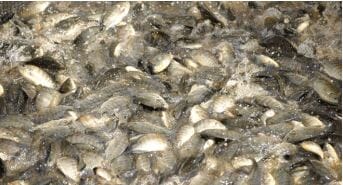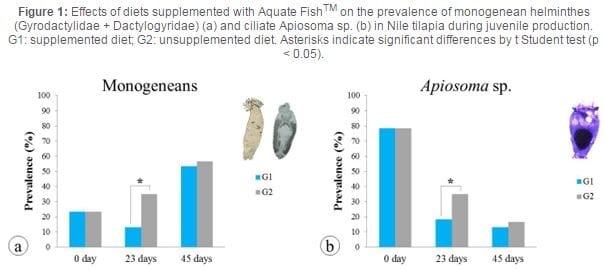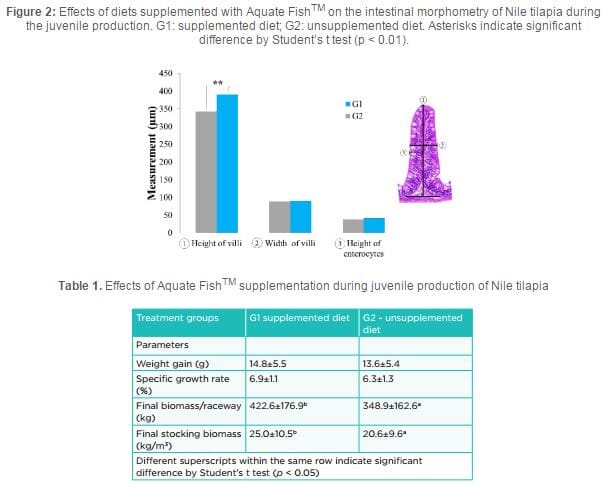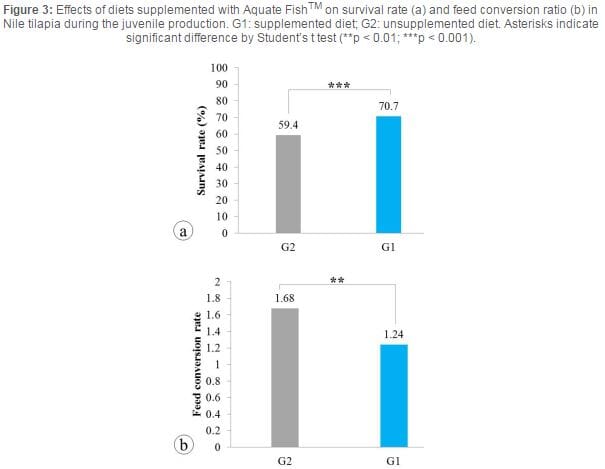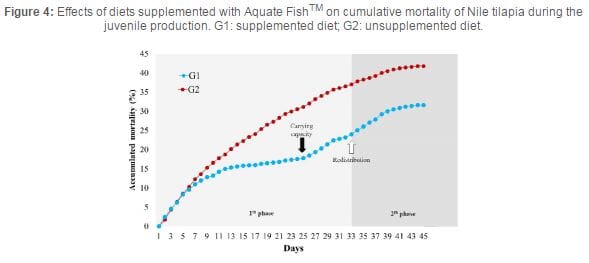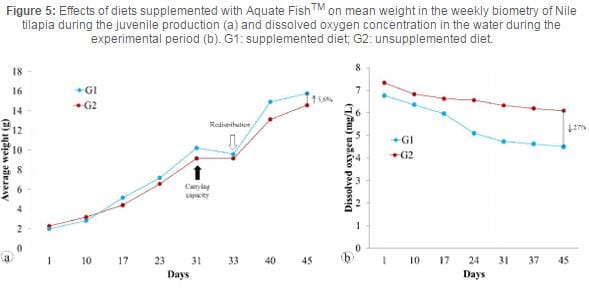As a result, the use of feed additives and supplemented diets to modulate the immunological system constitutes an important alternative for implementation of strategies to improve fish resistance against such challenges in its production.
Recently, we presented the results on the use of Aquate FishTM (Alltech, USA) during the masculinisation period in fingerlings of Nile tilapia (Pádua et al., 2014).
The feed additive, Aquate FishTM comprises different natural ingredients such as yeast and marine algae, organic minerals and vitamins and has been shown to promote health benefits in farmed fingerlings in hapas in Minas Gerais state, Brazil (Pádua et al., 2014).
In a new phase of this validation work, we evaluated this product in other farming conditions in northeast Brazil.
For this work, we selected AAT International, a leading juvenile fish producer and supplier to farms in Bahia state. AAT International specialises in fingerling and juvenile production of tilapia in raceways with high water exchange whilst the farming technology at Paulo Afonso Pole Production is intensive grow-out of tilapia in cage net systems, at stocking density of 60-150kg/m3.
Validation trials
For this test, a total of 300,000 fingerlings of Nile tilapia (Oreochromis niloticus) with a mean weight of 2.2 g were distributed in 6 raceways (each of 16.9 m3) with high water exchange (150 times a day) containing 50,000 fish per experimental unit (2 treatments and 3 replicates).
There were two treatments:
- G1 group: Fish were fed the treatment diet, supplemented with 6 g of Aquate FishTM/kg in extruded feed (Guabi Pirá Mirim®1.0 mm; and Guabi Pirá Alevinos® 1.7 mm). Top dressing of the additive in oil was carried out at the farm.
- G2 group: Fish were fed the unsupplemented diet i.e. extruded feed, Guabi Pirá Mirim® 1.0 mm and Guabi Pirá Alevinos® 1.7 mm.
Fish were maintained in this system for 33 days and then they were classified and redistributed in 8 raceways (2 treatments and 4 replicates) and kept in these raceways for 45 days.
Health evaluation
Parasitological analysis was carried out in situ at 0, 23 and 45 days in which the fish were netted out and samples of skin, fins and gills scrapings were observed under the microscope.
On day 0, we collected a total of 60 fish for baseline analysis and 60 fish per treatment were analysed on days 23 and 45. A total of 300 fish were subjected to diagnostic tests.
The diagnosis of parasite prevalence rate was calculated as proposed by Bush et al. (1997) and then ranked in the Parasite Intensity Score (working methodology established by Aquivet Saúde Aquática).
At the end of the experimental period, a total of six fish per raceway were collected and necropsied for histopathological analysis. Intestine fragments were fixed in neutral buffered 10 per cent formalin solution for histopathology, embedded in paraffin, sliced in 5 µm thick sections and stained with haematoxylin and eosin.
Photomicrographs were made in photomicroscope for anterior and medium intestine morphometry to obtain the following parameters: 1) intestinal height of villi 2) intestinal width of villi and 3) height of enterocytes.
Production performance
A hundred fish were sampled for biometry at 0, 23 and 45 days after feeding with experimental diets. Fish were weighed individually to the nearest 0.1 g using a balance and the length was measured with an ichthyometer.
For productive performance, the following parameters were measured: weight gain, specific growth rate (per cent), survival (per cent) and feed conversion ratio (FCR).
The data were subjected to a variance analysis (ANOVA) and, when significant, the means were compared by Student’s t test (p < 0.05).
Ectoparasite diagnosis
The supplementation of Aquate FishTM in the diet reduced the prevalence rate (p < 0.05) of the protozoan ciliate Apiosoma sp., as well as monogenean infection by Gyrodactylus cichlidarum (Gyrodactylidae).
No significant difference (p > 0.05) was shown in the prevalence of other parasites such as trichodinids or in the Parasite Intensity Score.
Nevertheless, in evaluating the prevalence in each sample, a reduced prevalence of monogenean and Apiosoma sp. (p < 0.05) was found 23 days after feeding (Figure 1).
Histopathological analysis
Intestinal morphometry showed significant (p < 0.01) increase in the height of intestinal villi in group G1 fish fed the supplemented diet. No difference was found in the width of the villi or the height of the enterocytes (Figure 2).
Production performance
No significant differences (p > 0.05) were observed in weight gain or specific growth rate of fish fed the supplemented (G1) and unsupplemented (G2) diets (Table 1).
Nevertheless, a significant increase (p < 0.001) in the survival rate (Figure 3a), and reduced feed conversion ratio (Figure 3b) was observed and resulted in higher biomass in supplemented fish raceways (p < 005).
Consequently, higher final stocking biomass (p < 0.05) was also reported in the group fed the supplemented diet.
During the experimental period we observed that the fish should be fed the supplemented diet for at least 8 days before a significant reduction (p < 0.05) in the cumulative mortality was achieved (Figure 4).
During our weekly biometry to feeding rate adjustment, we identified a point that showed a decrease in the mean weight of fish fed the supplemented diet and stabilisation of mean weight of fish fed the unsupplemented diet (Figure 5a).
We postulated that this occurred as a result of the carrying capacity of the raceways accompanied by a decrease in dissolved oxygen by approximately 27 per cent in the G1 group that was fed the supplemented diet (Figure 5b).
This was due to high stocking density and survival in the group fed the supplemented diet. In addition, during this period an increase in the mortality rate was observed in the G1 group fish (Figure 4).
Improvement in health conditions and growth performance
The addition of Aquate FishTM improved the health condition of farmed Nile tilapia during juvenile production. One of the most important fish responses was the increased resistance against ectoparasites that can favour opportunistic microorganisms and influence the survival rate.
Our observation was that enhancing the structure integrity of the anterior and medium intestines may provide better digestion and nutrient absorption. An increase in height of villi was in fact responsible for better absorption reflecting directly on the fish performance.
Based on the increase in the final biomass per raceway and high stocking biomass (p < 0.05), fish fed the supplemented diet showed increased weight gain and specific growth rate and survival.
Due to their enhanced survival the carrying capacity in the experimental raceways was reached more rapidly than was observed in the group fed the unsupplemented diet. This was responsible for the reduced weight 5 and 6 weeks after feeding.
Consequently, the high stocking density and decreased dissolved oxygen provoked unfavourable conditions for the group of fish fed Aquate FishTM which in turn could be the possible cause of higher mortality. This condition stabilised 5 days after the classification and redistribution to new raceways.
During the experimental period, we observed that 8 days of feeding was needed to obtain reduced mortality (p < 0.05). After 25 days of feeding, the survival rate of the group (G2) fed the unsupplemented diet reached only 68.8 per cent while the survival rate of the group fed the supplemented diet reached 94.1 per cent, i.e. a difference of 25.3 per cent.
Nevertheless, the challenges caused by the carrying capacity in the raceways and decreased dissolved oxygen were demonstrated as fish fed supplemented diet had 11.3 per cent more survivors (p < 0.001). In addition, fish fed supplemented diets showed more efficient feed conversion than fish fed the unsupplemented diet.
Conclusion
In these validation trials we have showed that the supplementation of Aquate FishTM (6g/kg) in diets promoted increased disease resistance in Nile tilapia against ectoparasites and improved the intestinal integrity resulting in high survival rates. It has also improved production efficiency during the juvenile production of tilapia in raceways.
This article first appeared on Aqua Culture Asia Pacific magazine, Mar/Apr 2015
June 2015

